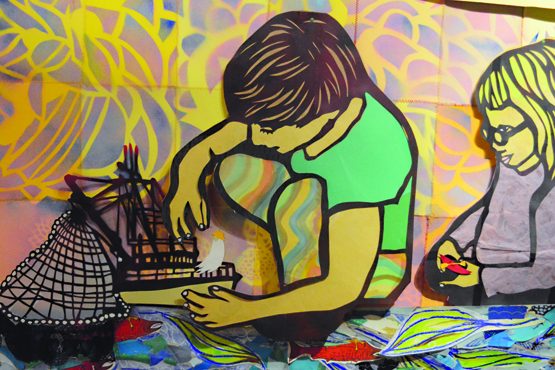In late January as Homer artist Desiree Hagen worked to finish her installation at Bunnell Street Arts Center, she sat surrounded by a tsunami of paper scraps. While many artists add media to create things — paint to canvas or clay to throwing wheel — Hagen, 31, is like the sculptor who looks at a block of marble and takes away pieces to reveal the art within.
“Usually what I do is reductive — where I’m cutting away something,” she said in her artist’s talk Feb. 5 at the opening of her show, “Seven Years,” at Bunnell Street Arts Center. “It’s a really meditative thing for me. I feel like I’m freeing the paper from itself.”
“Seven Years” refers to the time Hagen has spent in Alaska since moving to Homer from Kansas. Originally from Roanoke, Va., in the Appalachian Mountains, she came up here to visit some friends.
“They left and I stayed,” she said. “I realized I couldn’t live anywhere flat without water.”
Actually, Hagen will have lived in Homer eight years next month. The idea of seven years also refers to transitions that happen every seven years.
“People say that your cells are replaced after seven years,” Hagen said.
Hagen’s show covers all four gallery walls at Bunnell with works that might be big sprawling murals or sparse, elegant pieces that look like intricate snowflakes.
“This wall is a lot of stuff,” she said of the mural. “This one is simpler. It put my mind at ease.”
By cutting out a piece’s form, like a giant raven, and slicing into it to create lines, the result is lots and lots of paper.
“There was a giant scrap pile. It was cloudy to your head,” she said.
Hagen’s choice of media determined not just the form, but how she reacted to the media. She used found paper, handmade paper and paper stitched together because she couldn’t find giant pieces.
“You’re inspired by your limitations. I was limited by the materials I had,” she said. “I had that limitation, which sort of inspires creativity.”
Hagen worked as an artist-in-residence at Bunnell last month, during Bunnell’s winter hiatus where the gallery had no show on exhibit. Instead, Hagen used the gallery as her studio. Every Thursday she invited artists to join her. She’d assign them tasks, like painting watercolors.
“Doing things this size, you have a lot more hands to work, but also it’s a great learning experience,” Hagen said.
One artist, Kayla Spaan, sketched a life-size drawing of herself that Hagen then cut out.
“It’s like an old, wise Kayla. She’s like the art guardian that watches over me,” Hagen said of that piece. “The collaborative part of this project was one of my favorite things about it, because everything that somebody contributed lead to the next step in what I was doing.”
That collaboration will continue this month as Hagen teaches a workshop on shadow puppets from noon-4 p.m. Feb. 28 at Bunnell.
Hagen started after Christmas and finished in early Feburary — 40 days of work.
“I like the number. It’s Biblical, but that’s not why I like it,” Hagen said. “They say if you do something for 40 days, it changes you.”
The show illustrates where Hagen has lived for the past seven years in Homer and how she’s been influenced. Many of her cabins pop up in the murals. Oceans, mountains, wildflowers and animals swoop across the landscapes. A giant raven flies along one wall, trailing tear drops that look like lace.
“I wanted to show the places that have inspired me — what’s going to make Alaska special to me,” Hagen said.
Any plan Hagen had soon changed, she said.
“This was a huge opportunity for me. I had a plan in mind, but it changed,” she said. “It took me a while to get started, to really start creating.”
Eventually she got going.
“One part started, and then oh well, this is working, this is working, I added the next part,” she said. “It had that organic flow about it.”
As an installation, Hagen’s show exists mainly for the month. Hagen said she could see other uses for the work, though.
“I would like it if it got used in another way. Maybe the theater or someone could use it in a backdrop,” she said.
Bunnell director Asia Freeman praised Hagen’s work.
“It’s incredibly wonderful what she’s done,” she said. “It was a gift to all of us.”
“It was a gift to me. For me,” Hagen replied. “It was a great opportunity to do this.”
For her next project, Hagen is looking for studio space with running water so she can make paper using native plants — “the homesteader’s idea of trying to find a use for pushki,” she said.
Michael Armstrong can be reached at michael.armstrong@homernews.com.


